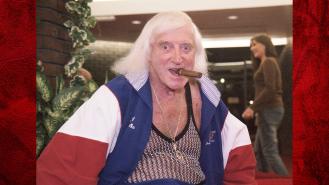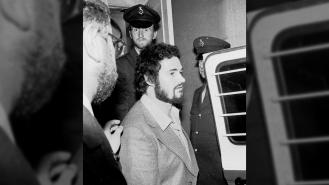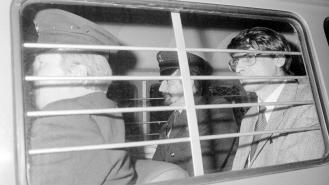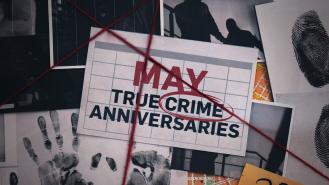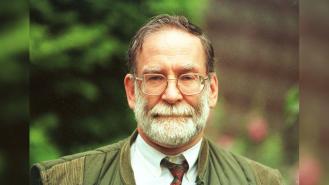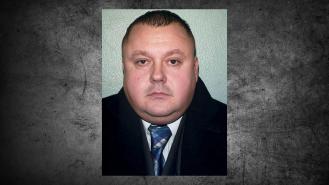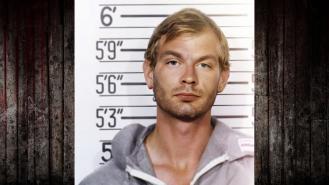“I think the temptation is to look at some of these guys as something particularly horrific or something particularly unusual but the reality is quite often they’re from a long line of particularly uninteresting, inadequate people...the reality is if they were more bizarre or strange then they would stand out and would have come to the attention of the authorities a lot earlier.”
Laurence Alison, Forensic Psychologist
ANNA
The police investigation into the attack on Anna Rogulskyj soon winds down. With no money or rape, the motive is unclear. With all the usual suspects such as the boyfriend cleared, the only lead was the neighbour’s vague description of a five foot eight man in his late twenties. The only distinct detail is that the attacker wore a check sports jacket.
OLIVE
When Olive Smelt is attacked, the same process repeats itself. It will take three years for the police to identify Olive’s attacker as the Ripper.
TRACY
As Tracy Browne walked with Sutcliffe for over 30 minutes, she’s able to give a very accurate description to the police.“I even mentioned the gap between his teeth and his insipid voice – a little man with a high-pitched voice.
”The ID picture appears in the papers. It’s such a good likeness that Sutcliffe jokes to his mother-in-law about the resemblance. The police never connect this attack with those of the Yorkshire Ripper.
WILMA
The Wilma McCann murder inquiry is headed by Detective Chief Superintendent Dennis Hoban. His pathologist tells him that Wilma was struck twice on the back of the head. She was then stabbed on her front 15 times. Traces of semen are found. It’s the first forensic evidence. As Wilma had been seen trying to hitch lifts from lorry drivers, 6,000 are interviewed. A further 7,000 are processed, including householders along her route home, associates, friends and family. It amounts to nothing.‘murder by person or persons unknown.’The coroner verdict of Wilma McCann.
EMILY
At 8am on 21 January 1976, Emily Jackson’s mutilated body is found. On top of her stab wounds, there is an imprint of a Wellington boot on her leg. Checks reveal it’s a size 7 Dunlop Warwick Wellington boot.Because she was so mutilated, Detective Chief Superintendent Hoban connects Wilma’s murder with Emily’s.
MARCELLA
Marcella Claxton, like Wilma McCann was hit over the head with a hammer. She is also able to give Hoban some key details about her attacker namely that he is bearded.But she is a prostitute and she is black. In 1976, that means there is little sympathy from the public and scant political pressure on the police to track down her assailant.
IRENE
Detective Chief Superintendent Jim Hobson replaces Hoban. He sees his first ‘Ripper’ victim on 6 February 1977. Irene Richardson’s intestines have spilled onto the street.Vaginal swabs indicate sexual activity by the assailant. He had masturbated over his victim, rather than raping her.Tyre tracks nearby offer hope. But laborious hand checking of every possible vehicle reveals 100,000 possible matches.
‘TINA’Patricia Atkinson had last been seen out on Saturday 23 April 1977. Inside her flat, next to her battered and bloodied body, is a size 7 Dunlop Warwick boot print.
JAYNE
The murder in June of Jayne MacDonald, an ‘innocent’, brings the press and public down in full force on the police. Assistant Chief Constable George Oldfield is now in charge. The investigation is run from the Milgarth station in the centre of Leeds.
The task is monumental. Police process through punch cards, paper statements and transfer everything in longhand.“I would say we were sort of still not quite in the bronze age with regards to paper but that’s how we worked....there was something up to 4 tonnes of paperwork held at Millgarth police station which caused the floors to creak and of course that had to be reinforced. But there was no other system.”Andrew Laptew, Detective ConstableThe largest manhunt in British history is gearing up.Police will question Sutcliffe nine times. Every time, the police will accept his alibi.
MAUREEN
Maureen Long should be dead from the injuries she sustains on 10 July 1977. Assistant Chief Constable Oldfield pleads to speak to her before surgery. She gives a brief description of a white 35-year-old man.
After her operation, she remembers nothing.But a night watchman tells police he saw a white car with black roof leaving the scene. This is Sutcliffe’s car. But the guard wrongly says it’s a Ford Cortina Mark II. This is the favoured model of thousands of taxi drivers. One taxi driver is placed under 24-hour surveillance. Meanwhile, over 300 police interview nearly 200,000 people.At the end of August, Sutcliffe replaces his white Corsair car with a red one.“When the murders broke in Manchester we thought well, he’s spreading his territory, his hunting ground. And there was a fear that, where’s it gonna end, where’s he gonna extend these boundaries? Really, you couldn’t predict where it was going to be.”Andrew Laptew, Detective Constable
JEAN
On 15 October, the police find Manchester mum of two Jean Jordan’s missing handbag. They also find the hidden compartment where she’d secreted Sutcliffe’s £5 note. Exhaustive investigations narrow potential interviewees down to 8,000 men. They interview Sutcliffe at home. Sutcliffe calmly convinces them he was home the night of Jean’s murder. On the later date, when her body was nearly decapitated, he says he had a housewarming party. His wife confirms his alibis.
MARILYN
Another survivor of Sutcliffe, Marilyn Moore, gives police a now familiar description of a white, bearded thirty-something man. Tyre tracks match those at the scene of Irene Richardson.
YVONNE
Yvonne Pearson’s body is only discovered in March, two months after her murder. As Sutcliffe had been disturbed, he hadn’t stabbed her. Police aren’t sure to connect her to the Ripper victims.
HELEN RYTKAA
Police dog discovers her body on 3 February 1978. The hammer and stab wounds are frighteningly familiar.
VERA
At 8:10am on Wednesday 17 May, the mutilated body of Vera Millward is found. Tyre tracks nearby match those found at Marilyn and Irene’s crime scenes.Police are stumped as to why the killings stop for the next 11 months.
JO
The hammer and stab wounds on Josephine Whitaker confirm the return of ‘The Ripper’ in April 1979.On 16 April, Oldfield announces a new lead. Letters sent to him claiming to be from the Ripper postmarked Sunderland, have forensic matches to previous cases. Despite the predictions in the letters having been wrong as often as they’re right, Oldfield is convinced of their authenticity when an audiotape later arrives.“I’m Jack. I see you are still having no luck catching me. I have the greatest respect for you George but Lord, you are no nearer catching me now than four years ago when I started.”
Experts say it’s a Wearside accent and the speaker becomes known as “Wearside Jack”. Police attention is diverted wholly to the search for this person. When the voice is played at a press conference, 50,000 calls are made to the police. It is the last thing an investigation buried in paperwork needs.
The voice taunts Oldfield. He becomes obsessed by finding that voice.“…what you often get in police investigations that are of this magnitude is what psychologists call confirmation bias, where a certain piece of information looks quite attractive and when you have that attractive information and you want to solve the case and you want it to end. Your mind tends to fixate on that piece of information and fail to question it, fail to consider alternatives and fail to look at all the reasons why that information is not helpful to you.”
Laurence Alison, Forensic Psychologist
Police interview 40,000 suspects and a £1million publicity campaign launches. Wearside Jack’s letters are reproduced on posters and billboards.
On 29 July 1979, police visit Sutcliffe about his vehicle being in the red light districts of Manchester, Leeds and Bradford.But Sutcliffe’s handwriting doesn’t match ‘Jack’’s and his softly spoken accent isn’t Geordie. And crucially, the police interviewing him aren’t aware that he’s been spoken to four times before. One of those times was to do with the ‘£5 note’ inquiry.
Despite being unaware of all of this, Detective Constable Andrew Laptew is deeply suspicious of Sutcliffe. He compiles a report and takes it to a senior officer. The officer dresses Laptew down for ignoring the lack of accent match and the insistence on matching photo fits.Sutcliffe is again discounted.
This is one of the nine times that Sutcliffe is interviewed before being arrested.Three more women will die after Laptew’s report on Sutcliffe.The stress takes down Oldfield who suffers several heart attacks and is hospitalised.
Police officers become objects of derision for their inability to get their man.
“You know, you’d go for a drink somewhere to your local and they’d ridicule you.”
Andrew Laptew, Detective Constable
BARBARA
On 2 September 1979 the body of another victim is found. Barbara Leach isn’t a prostitute, she’s a student. Vigilante groups now patrol the streets.
The police publicity campaign reminds people to be on the lookout for men with a Geordie accent.
Finally, a new computer programme is used to track the registration numbers of vehicles sighted near the attacks. But if anything, it just adds to the information overload.
Police narrow down the list of suspects who received the new £5 note found in Jean Jordan’s handbag to just 300. Sutcliffe is on this list, has a beard, a gap in his teeth and his car has repeatedly been seen in red light districts.
But Sutcliffe’s wife provides him with alibis and he doesn’t have a Geordie accent.
MARGUERITE
Because Sutcliffe strangles Marguerite Walls in August 1980, she isn’t initially included as a Ripper victim.BANDARADr Bandara Upadhya is walking the suburban streets on 24 September when she’s attacked. A neighbour comes out because of the noise and the doctor lives. Despite being hammered and describing the attacker as having a beard, police don’t connect her attack.
THERESA
Theresa Syke’s boyfriend hears the screams and is watching through the window of their home as the hammer goes through her skull. He shoots out and Sutcliffe speeds off. Police again don’t connect her attack.
JACQUELINE
Jacqueline Hill’s handbag is found by another student. He takes it home and shows it to his flatmate who, remarkably, is an ex-Hong Kong policeman. Seeing that nothing has been stolen and there’s blood on it, he calls the police.Again, police are reluctant to call Jacqueline a Ripper victim.When they do, middle England erupts. Feminist marches demand curfews for men. Panic and paranoia spreads and thousands of anonymous letters are sent to the police naming hundreds and hundreds of suspects.Sutcliffe’s cruising partner, Trevor Birdsall informs on him. He recounts a night in 1969 when Sutcliffe had returned from a prostitute saying he’d tried to kill her with a brick in a sock. Only the tearing of the sock had saved her.The constable he tells it to files the report. It is just yet more paperwork being fed into the system.The investigation is now out of control. Oldfield is replaced by Jim Hobson. He tells police not to discount suspects based on their accent.Finally, Sutcliffe is caught by simple, solid policing.

